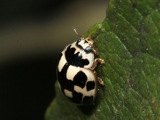
Русские, остановите эту войну! Спасите Свободную Украину!
Russians, stop this war! Save Free Ukraine!
Biodiversity Map
Taxa

Propylea — subordinate taxa:
Taxon count: 1
-
Arthropodaphylum
Click to switch
to select orders
and filters > -
Hexapodasubphylum
Click to switch
to select orders
and filters > -
Insectaclass
Click to switch
to select orders
and filters > -
Coleopteraorder
Click to set
as the main taxon
and as a base
← of the left panel > -
Polyphagasuborder
Click to set
as the main taxon
and as a base
← of the left panel > -
Cucujiformiaseries
Click to set
as the main taxon
and as a base
← of the left panel > -
Cucujoideasuperfamily
Click to set
as the main taxon
and as a base
← of the left panel > -
Coccinellidaefamily
Click to set
as the main taxon
and as a base
← of the left panel > -
Coccinellinaesubfamily
Click to set
as the main taxon
and as a base
← of the left panel > -
Coccinellinitribe
Click to set
as the main taxon
and as a base
← of the left panel > -
Propyleagenus
Click to set
as the main taxon
and as a base
← of the left panel >
PL
YES
name status: valid name
BioMap ID: 1020013
taxon code: 3623
taxonomy checked: YES
Data on distribution in Poland

Statistics
- Records: 279
- Publications: 22
- Collections: 13
- Publication authors: 30
- Illustrations (iconography): 1
- Photos (specimen/observation): 16
Taxon description
Gatunek szeroko rozmieszczony w Palearktyce, występujący w prawie całej Europie. Północna granica zasięgu przebiega poniżej koła podbiegunowego. Pospolity, eurytopowy gatunek zasiedlający najróżnorodniejsze wilgotne i suche środowiska, unikający jednak lasów iglastych, znajdowany szczególnie często w środowiskach o charakterze ruderalnym. Odżywia się różnymi mszycami, żerującymi na krzewach i drzewach liściastych (również owocowych), na bylinach, roślinach zielnych i trawach. Zimuje w ściółce i na ziemi pod suchymi szczątkami roślinnymi.
Illustrations
... browse
 Propylea
Propyleaquatuordecimpunctata
Selected photos
... browse
 Propylea
Propyleaquatuordecimpunctata
 Propylea
Propyleaquatuordecimpunctata
 Propylea
Propyleaquatuordecimpunctata
 Propylea
Propyleaquatuordecimpunctata
-s.jpg) Propylea
Propyleaquatuordecimpunctata
 Propylea
Propyleaquatuordecimpunctata
 Propylea
Propyleaquatuordecimpunctata
 Propylea
Propyleaquatuordecimpunctata
External data sources
- Ostatnie rekordy
-
1140724
 ⊡
⊡ Coccinellidae: Propylea quatuordecimpunctata, PL, Pojezierze Pomorskie, Pojezierze Południowopomorskie, Równina Charzykowska, P.N. Borów Tucholskich, pomorskie, Chojnice, Chojnice w., ad Bachorze, UTM XV66, 1998 (Gutowski et al. 2005a)
Coccinellidae: Propylea quatuordecimpunctata, PL, Pojezierze Pomorskie, Pojezierze Południowopomorskie, Równina Charzykowska, P.N. Borów Tucholskich, pomorskie, Chojnice, Chojnice w., ad Bachorze, UTM XV66, 1998 (Gutowski et al. 2005a) -
1140723
 ⊡
⊡ Coccinellidae: Propylea quatuordecimpunctata, PL, Pojezierze Pomorskie, Pojezierze Południowopomorskie, Bory Tucholskie, nadl. Osie, Wdecki P.K., kujawsko-pomorskie, Świecie, Osie, ad Osie, UTM CE24, 1998 (Gutowski et al. 2005a)
Coccinellidae: Propylea quatuordecimpunctata, PL, Pojezierze Pomorskie, Pojezierze Południowopomorskie, Bory Tucholskie, nadl. Osie, Wdecki P.K., kujawsko-pomorskie, Świecie, Osie, ad Osie, UTM CE24, 1998 (Gutowski et al. 2005a) -
1140722
 ⊡
⊡ Coccinellidae: Propylea quatuordecimpunctata, PL, Pojezierze Pomorskie, Pojezierze Południowopomorskie, Bory Tucholskie, Zaborski P.K., pomorskie, Chojnice, Brusy, ad Laska, UTM XV67, 1998 (Gutowski et al. 2005a)
Coccinellidae: Propylea quatuordecimpunctata, PL, Pojezierze Pomorskie, Pojezierze Południowopomorskie, Bory Tucholskie, Zaborski P.K., pomorskie, Chojnice, Brusy, ad Laska, UTM XV67, 1998 (Gutowski et al. 2005a) -
1115280
 ⊡
⊡ Coccinellidae: Propylea quatuordecimpunctata, PL, Wyżyna Krakowsko-Wieluńska, Brama Krakowska, Obniżenie Cholerzyńskie, małopolskie, Kraków m., Kraków, Bronowice, UTM DA14, 2019, leg. M. Syratt
Coccinellidae: Propylea quatuordecimpunctata, PL, Wyżyna Krakowsko-Wieluńska, Brama Krakowska, Obniżenie Cholerzyńskie, małopolskie, Kraków m., Kraków, Bronowice, UTM DA14, 2019, leg. M. Syratt -
1115266
 ⊡
⊡ Coccinellidae: Propylea quatuordecimpunctata, PL, Wyżyna Krakowsko-Wieluńska, Brama Krakowska, Obniżenie Cholerzyńskie, małopolskie, Kraków m., Kraków, Bronowice, UTM DA14, 2019, leg. M. Syratt
Coccinellidae: Propylea quatuordecimpunctata, PL, Wyżyna Krakowsko-Wieluńska, Brama Krakowska, Obniżenie Cholerzyńskie, małopolskie, Kraków m., Kraków, Bronowice, UTM DA14, 2019, leg. M. Syratt -
1112475
 ⊡
⊡ Coccinellidae: Propylea quatuordecimpunctata, PL, Roztocze, Roztocze, Wieprzów, UTM FA79, 2011, leg. J. Mazepa
Coccinellidae: Propylea quatuordecimpunctata, PL, Roztocze, Roztocze, Wieprzów, UTM FA79, 2011, leg. J. Mazepa -
1112473
 ⊡
⊡ Coccinellidae: Propylea quatuordecimpunctata, PL, pobrzeże Bałtyku, Pobrzeże Bałtyku, Sarbinowo, UTM WA61, 2012, leg. J. Mazepa
Coccinellidae: Propylea quatuordecimpunctata, PL, pobrzeże Bałtyku, Pobrzeże Bałtyku, Sarbinowo, UTM WA61, 2012, leg. J. Mazepa -
1075294
 ⊡
⊡ Coccinellidae: Propylea quatuordecimpunctata, PL, Podlasie, Biebrzański P.N., podlaskie, ad Stójka, UTM FE00, 2015, leg. A. Lasoń
Coccinellidae: Propylea quatuordecimpunctata, PL, Podlasie, Biebrzański P.N., podlaskie, ad Stójka, UTM FE00, 2015, leg. A. Lasoń -
1061507
 ⊡
⊡ Coccinellidae: Propylea quatuordecimpunctata, PL, Wyżyna Małopolska, Łódź, UTM CC93, 1990, leg. J. Siekierski
Coccinellidae: Propylea quatuordecimpunctata, PL, Wyżyna Małopolska, Łódź, UTM CC93, 1990, leg. J. Siekierski -
1059324
 ⊡
⊡ Coccinellidae: Propylea quatuordecimpunctata, PL, Wyżyna Małopolska, Łódź, UTM CC93, 1989, leg. J. Siekierski
Coccinellidae: Propylea quatuordecimpunctata, PL, Wyżyna Małopolska, Łódź, UTM CC93, 1989, leg. J. Siekierski - ... more
- Powiązane publikacje
-
Jaworska-Krzymińska J. 2011. Biedronki ważnym czynnikiem ograniczającym populację mszyc w uprawie wierzby energetycznej. Prog. Plant Protection/Post. Ochr. Roślin., 51(3):1265-1268.
 Show records
Show records -
Bubienko K., Ciepielewska D. 2010. Ladybirds (Coleoptera, Coccinellidae) on the beaches of Gdańsk. Aphids and Other Hemipterous Insects, 16:119-125.
 Show records
Show records -
Bubienko K., Kosewska A., Ciepielewska D. 2010. Ladybirds (Coleoptera, Coccinellidae) of midfield thickets. Aphids and Other Hemipterous Insects, 16:107-117.
 Show records
Show records -
Aleksandrowicz O. 2009a. Zmiany składu gatunkowego i struktury ekologicznej zgrupowań chrząszczy epigeicznych brzegów rzek Kwacza i Słupia pod wpływem zabiegów renaturalizacyjnych. [In:] Obolewski K. (Ed.) Krótkoterminowe ekologiczne efekty renaturalizacji niewielkich rzek nizinnych na przykładzie reki Kwaczy. PK „Dolina Słupi”, APSL., Słupsk. pp. 239-262.
 Show records
Show records -
Wolender M., Zych A. 2007. Beetles (Coleoptera) from seaside beach and dunes in the regions of Świnoujście, Międzyzdroje and Wisełka (Poland) located along the southern coast of the Baltic Sea. Baltic J. Coleopterol., 7:61-71.
 Show records
Show records - ... more






